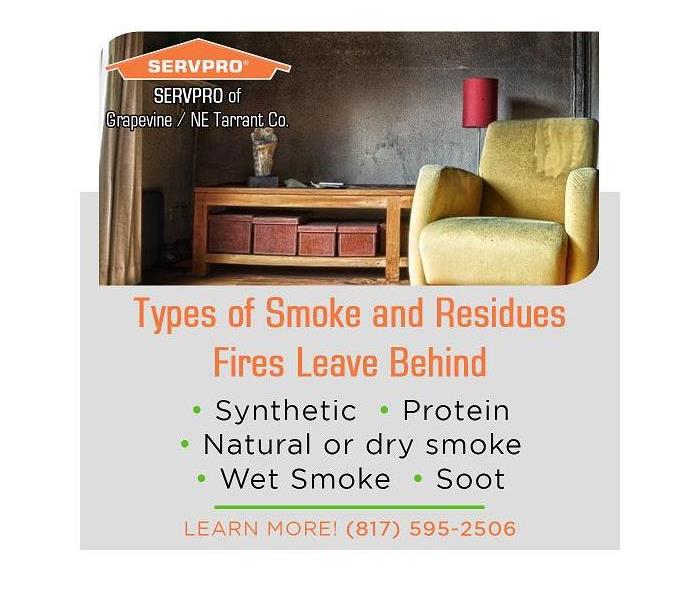SERVPRO: Smoke and residues that fires result in
9/17/2021 (Permalink)
Blog summary: This SERVPRO blog talks of the various types of smoke and residues that fires leave behind in homes. This information is intended to help homeowners identify them and address them on time.
Types of smoke and residues fires leave behind
When the fire is extinguished, the damage in the house is not limited to the damage caused by the actual flames. Smoke and soot can also cause visible and invisible damage. SERVPRO shares how to identify soot and smoke damage.
- Synthetic: Synthetic, oil-based materials such as plastics and fabrics burn to produce thick black smoke. This smoke leaves behind a smeary residue that can be very messy if not cleaned properly. This could include everything from window coverings, furniture, carpets, and electronics. When synthetic materials burn they produce a cloud of thick black smoke and a residue that clings to objects and walls.
Vacuuming is usually the preferable option followed by dry-chem sponge cleaning.
- Protein: Kitchen fires caused by the burning of proteins such as meats and beans often leave behind a yellowish-brown residue that looks like grease. This grease can cling to painted surfaces and wood causing permanent discoloration. The removal of this residue must be done using chemicals formulated for protein-based residues.
- Natural or dry smoke: The burning of natural products such as wood and paper produces a dry powdery residue that is greyish-black in color. These are easier to clean up compared to synthetic or protein residues. Since this residue is so fine, it can fall easily into cracks and crevices, obscured from view. If not cleaned properly the odor may remain. Vacuuming with a bristled brush, followed by dry-chem sponge cleaning are the recommended methods.
- Wet Smoke: Wet smoke is caused by the burning of rubber or plastic. It occurs during a slow-burning fire with a low temperature. The odor it leaves behind is extremely strong. Moreover, cleaning the thick residue is a time-consuming and tedious process that requires professional help.
- Soot
Soot is almost always the result of a fire. It’s a powdery black substance that occurs when the fuel source doesn’t burn completely. Soot ionizes and sticks to all different types of surfaces and is very difficult to clean and remove. This fine powder can even get stuck in the HVAC system and get distributed throughout the building. Soot inhalation can pose serious health effects to the inhabitants if not checked properly. Thorough removal of soot, smoke, and the odor by a professional fire restoration specialist such as SERVPRO is recommended after a fire to ensure complete safety.
Why SERVPRO?
Faster to Any Size Emergency
No matter where and how big the disaster is, SERVPRO can reach across 1,700 US and Canadian franchise locations and help its customers swiftly. The vast network of resources available to SERVPRO enables it to act immediately and efficiently. The water damage timeline above showcases the various stages of damage and the extent of restoration work it needs. A 24X7 emergency response gives SERVPRO the ability to arrest any disaster quickly and save huge amounts of money, time, and energy.
Advanced Technology
SERVPRO uses state-of-the-art equipment to bring the damaged property back to its original state. SERVPRO of Grapevine / NE Tarrant County is always updating its fleet and equipment so clients in Southlake, Grapevine, Keller, or anywhere else can quickly access the services.
Certified Professionals
The SERVPRO staff is highly trained in fire damage restoration and other restoration services. They receive initial in-house training and constant skill up-gradation at the corporate training facility and also acquire the regular IICRC-industry certification.
For fire damage restoration services, call SERVPRO of Grapevine / NE Tarrant County today at (817) 595-2506 or e-mail at office@SERVPROheb.com






 24/7 Emergency Service
24/7 Emergency Service
